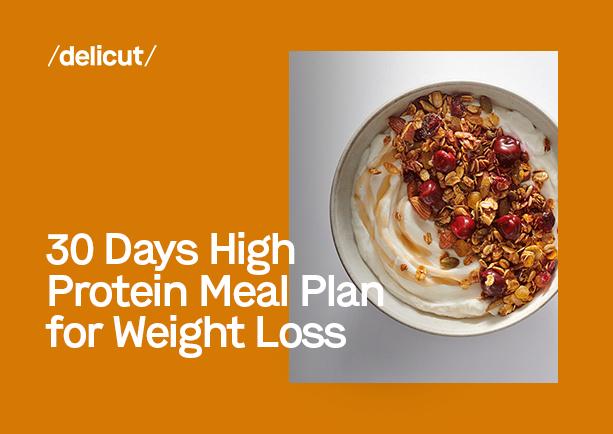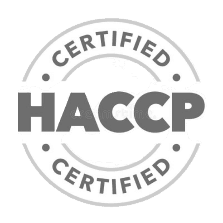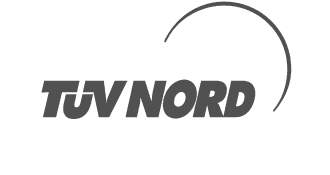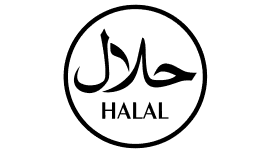30 Days High-Protein Meal Plan for Weight Loss

While starting a weight loss programme can be intimidating at first, it can also be empowering and fulfilling when done correctly. Including protein-rich meals is one of the best ways to lose weight. Protein is essential for building muscle, increasing metabolism, and prolonging feelings of fullness.
Our meal plan focuses on balanced nutrition, ensuring you get all the essential nutrients while maximising your protein intake. Whether you're just starting your weight loss journey or looking to break through a plateau, this plan is tailored to help you achieve your goals.
What are the Benefits of High-Protein Meals for Weight Loss?
Protein is a powerhouse nutrient that can significantly impact your weight loss journey. Increasing your protein intake, you can experience reduced hunger and cravings, making it easier to adhere to a calorie deficit.
High-protein meals help preserve muscle mass during weight loss, ensuring that the weight you lose is primarily fat. Moreover, protein boosts your metabolism, allowing you to burn more calories even at rest. These benefits make high-protein meals an excellent choice for anyone looking to lose weight effectively.
How to Create a Balanced High-Protein Meal Plan?
While focusing on protein, it's crucial to maintain a balanced diet that includes healthy fats and carbohydrates. This balance ensures your body gets all the essential nutrients it needs to function optimally.
Incorporating various foods can prevent meal fatigue and help you stick to your plan. Aim for a macronutrient distribution that supports weight loss: approximately 40% protein, 30% fats, and 30% carbohydrates.
High-protein Weekly Meal Plan Breakdown for Weightloss
Achieving your weight loss goals with high-protein meals is made easier with a structured and varied plan. Each week, we'll introduce different protein-rich foods and recipes to keep your meals exciting and nutritious. Here’s a detailed breakdown for each week, ensuring you stay on track with your high-protein meals to lose weight:
Week 1
In the first week, we focus on simple, easy-to-prepare high-protein meals that set a solid foundation for your weight loss journey.
Breakfast: Greek Yogurt Parfait with Berries and Nuts
Ingredients:
- 1 cup Greek yogurt
- 1/2 cup mixed berries
- 1/4 cup nuts (almonds, walnuts)
Instructions:
- Layer Greek yogurt
- berries, nuts in a bowl
- Enjoy immediately.
Lunch: Grilled Chicken Salad with Quinoa and Vegetables
Ingredients:
- 1 grilled chicken breast
- Sliced
- 1 cup cooked quinoa
- 1 cup mixed vegetables (tomatoes, cucumbers, bell peppers)
- 2 tbsp olive oil
- 1 tbsp lemon juice
Instructions:
- Combine chicken, quinoa, and vegetables in a bowl.
- Drizzle with olive oil and lemon juice.
- Toss to combine and serve.
Dinner: Baked Salmon with Roasted Vegetables
Ingredients:
- 2 salmon fillets
- 2 cups mixed vegetables (zucchini, bell peppers, onions)
- 2 tbsp olive oil, salt and pepper to taste
Instructions:
- Preheat oven to 400°F (200°C).
- Place salmon and vegetables on a baking sheet.
- Drizzle with olive oil, salt, and pepper.
- Bake for 20 minutes or until salmon is cooked through.
Snack: Cottage Cheese with Pineapple
Ingredients:
- 1 cup cottage cheese
- 1/2 cup pineapple chunks
Instructions:
- Combine cottage cheese and pineapple in a bowl. Serve chilled.
Week 2
This week, we add more variety to your high-protein meals, ensuring you get a diverse range of nutrients while staying on track with your weight loss goals.
Breakfast: Protein-Packed Smoothie with Spinach and Avocado
Ingredients:
- 1 cup spinach
- 1/2 avocado
- 1 banana
- 1 scoop protein powder
- 1 cup almond milk
Instructions:
- Blend all ingredients until smooth.
- Serve chilled.
Lunch: Tuna and Avocado Lettuce Wraps
Ingredients:
- 1 can tuna, drained
- 1 avocado, mashed
- 8 large lettuce leaves
- 1 tbsp lemon juice
- Salt and pepper to taste
Instructions:
- Mix tuna, avocado, lemon juice, salt, and pepper.
- Spoon mixture into lettuce leaves.
- Roll up and enjoy.
Dinner: Lean Beef Stir-Fry with Broccoli and Bell Peppers
Ingredients:
- 1 lb lean beef sliced thin
- 2 cups broccoli florets
- 1 bell pepper, sliced
- 2 tbsp soy sauce
- 1 tbsp olive oil
Instructions:
- Heat olive oil in a pan over medium-high heat.
- Add beef and cook until browned.
- Add broccoli and bell pepper, and stir-fry for 5 minutes.
- Add soy sauce and cook for another 2 minutes.
- Serve hot.
Snack: Hard-boiled eggs and Almonds
Ingredients:
- 2 hard-boiled eggs
- 1/4 cup almonds
Instructions:
- Peel eggs and serve with almonds.
Week 3: Midway Check and Adjustments
Midway through the month, we make slight adjustments to ensure continuous progress. This week, we will introduce different protein sources and meal-prepping tips for convenience.
Breakfast: Scrambled Eggs with Spinach and Feta
Ingredients:
- 2 eggs
- 1/2 cup spinach
- 1/4 cup feta cheese
- Salt and pepper to taste
Instructions:
- Scramble eggs with spinach and feta.
- Season with salt and pepper.
- Serve hot.
Lunch: Turkey and Veggie Lettuce Wraps
Ingredients:
- 4 slices turkey breast
- 1 cup mixed vegetables (shredded carrots, bell peppers, cucumbers)
- 8 large lettuce leaves
- 2 tbsp hummus
Instructions:
- Place turkey and vegetables in lettuce leaves.
- Add a dollop of hummus.
- Roll up and enjoy.
Dinner: Grilled Shrimp with Zucchini Noodles
Ingredients:
- 1 lb shrimp, peeled and deveined
- 2 zucchinis, spiralised
- 2 tbsp olive oil
- 1 clove garlic, minced, salt and pepper to taste
Instructions:
- Heat olive oil in a pan over medium heat.
- Add garlic and shrimp.
- Cook until shrimp is pink.
- Add zucchini noodles and cook for 2-3 minutes.
- Season with salt and pepper.
- Serve hot.
Snack: Hummus with Carrot and Cucumber Sticks
Ingredients:
- 1/2 cup hummus
- 1 cup carrot sticks
- 1 cup cucumber sticks
Instructions:
- Serve hummus with carrot and cucumber sticks.
Week 4: Final Push to Achieve Goals
In the final week, we intensify protein intake to maximise results, ensuring a balance between variety and sustainability in meal choices.
Breakfast: Chia Seed Pudding with Almond Milk and Berries
Ingredients:
- 1/4 cup chia seeds
- 1 cup almond milk
- 1/2 cup mixed berries
- 1 tsp honey (optional)
Instructions:
- Mix chia seeds and almond milk in a bowl.
- Refrigerate overnight.
- Top with berries and honey before serving.
Lunch: Chicken and Quinoa Stuffed Peppers
Ingredients:
- 4 bell peppers, halved and seeded
- 2 cups cooked quinoa
- 2 cups shredded chicken
- 1 cup tomato sauce
- 1/2 cup shredded cheese
Instructions:
- Preheat oven to 375°F (190°C).
- Mix quinoa, chicken, and tomato sauce.
- Fill bell pepper halves with mixture.
- Top with shredded cheese.
- Bake for 25-30 minutes.
Dinner: Baked Cod with Asparagus and Sweet Potatoes
Ingredients:
- 2 cod fillets
- 1 bunch asparagus
- 2 sweet potatoes
- 2 tbsp olive oil
- Salt and pepper to taste
Instructions:
- Preheat oven to 400°F (200°C).
- Place cod, asparagus, and sweet potatoes on a baking sheet.
- Drizzle with olive oil, salt, and pepper.
- Bake for 20 minutes or until the cod is cooked through.
Snack: Greek Yogurt with a Sprinkle of Nuts
Ingredients:
- 1 cup Greek yogurt
- 1/4 cup mixed nuts
Instructions:
- Serve Greek yogurt with mixed nuts.
In Conclusion
Adopting a high-protein meal plan can be a game-changer in your weight loss journey. By focusing on protein-rich foods, you not only enhance your metabolism and build muscle but also keep hunger at bay, making it easier to maintain a calorie deficit. Our 30-day high-protein meal plan is designed to provide you with various delicious and nutritious meals, ensuring that you stay satisfied and energised throughout the month.
FAQs
1. What are the benefits of following a high-protein meal plan for 30 days?
Following a high-protein meal plan for 30 days can enhance muscle growth, boost metabolism, and increase satiety, making it easier to control cravings and reduce overall calorie intake. This approach supports effective weight loss and helps maintain muscle mass.
2. How much protein should I consume daily for weight loss?
For weight loss, consuming between 1.2 to 2.2 grams of protein per kilogram of body weight is generally recommended. This amount can vary based on individual needs, activity level, and dietary goals, so consulting a healthcare provider or nutritionist can provide personalised guidance.
3. What are some examples of high-protein foods?
High-protein foods include lean meats like chicken and turkey, fish, eggs, dairy products such as Greek yogurt and cottage cheese, legumes like beans and lentils, tofu, quinoa, and nuts and seeds. Incorporating a variety of these foods ensures adequate protein intake and nutritional diversity.
4. How do I balance protein intake with other nutrients?
Balance your meals by including various macronutrients: proteins, carbohydrates, and fats. Aim for a mix of lean proteins, whole grains, and healthy fats in each meal. For example, pair grilled chicken (protein) with quinoa (carbs) and avocado (fats) to create a well-rounded dish.
5. Are there any potential risks or side effects of a high-protein diet?
While a high-protein diet can be beneficial, it may lead to potential risks such as kidney strain, dehydration, or nutrient imbalances if not properly managed. To avoid these issues, it's important to stay hydrated, choose lean protein sources, and ensure adequate intake of other essential nutrients. Consulting with a healthcare provider is advisable.
Read More:
20-Day Meal Plan for Heart Health: Strengthen Your Heart
20-Day Meal Plan for Improved Digestion: Enhance Your Gut Health
15-Day Vegan Meal Plan for New Mothers: Nourishing Recipes and Tips
10-Day Anti-Inflammatory Meal Plan for Seniors: Recipes and Benefits
Related Blogs
Why do most people in the UAE get their calories wrong
Dec 8, 2025 | 6DASH Diet Meal Plan
Nov 11, 2025 | 8Fatty Liver Meal Plan
Oct 31, 2025 | 8Pregnancy Diet Meal Plan
Oct 27, 2025 | 82000 Calorie Meal Plan
Oct 1, 2025 | 8Intermittent Fasting Diet Plan
Sep 5, 2025 | 81000 Calorie Meal Plan
Sep 5, 2025 | 8High-Protein Meal Plans
Sep 5, 2025 | 8How to Choose the Right Meal Plan for Your Fitness Goals
Sep 5, 2025 | 8The GM diet plan: Is it possible to shed fat in just 7 days?
Sep 5, 2025 | 8






